Deck 23: The Respiratory System
Question
Question
Question
Question
Question
Question
Question
Question
Question
Question
Question
Question
Question
Question
Question
Question
Question
Question
Question
Question
Question
Question
Question
Question
Question
Question
Question
Question
Question
Question
Question
Question
Question
Question
Question
Question
Question
Question
Question
Question
Question
Question
Question
Question
Question
Question
Question
Question
Question
Question
Question
Question
Question
Question
Question
Question
Question
Question
Question
Question
Question
Question
Question
Question
Question
Question
Question
Question
Question
Question
Question
Question
Question
Question
Question
Question
Question
Question
Question
Question

Unlock Deck
Sign up to unlock the cards in this deck!
Unlock Deck
Unlock Deck
1/85
Play
Full screen (f)
Deck 23: The Respiratory System
1
The gas law that describes the pressure changes that occur during pulmonary ventilation is
A)Boyle's law
B)Charles' law
C)Henry's law
D)The inhalation law
E)The law of partial pressure
A)Boyle's law
B)Charles' law
C)Henry's law
D)The inhalation law
E)The law of partial pressure
A
2
Which of the following indicates the direction of diffusion of gases at the alveoli of the lungs?
A)Oxygen into blood,Carbon dioxide into blood
B)Oxygen out of blood,Carbon dioxide into blood
C)Oxygen into blood,Carbon dioxide out of blood
D)Oxygen out of blood,Carbon dioxide out of blood
A)Oxygen into blood,Carbon dioxide into blood
B)Oxygen out of blood,Carbon dioxide into blood
C)Oxygen into blood,Carbon dioxide out of blood
D)Oxygen out of blood,Carbon dioxide out of blood
C
3
Which structure is located anterior to the esophagus and carries air to the bronchi?
A)Trachea
B)Larynx
C)Nasopharynx
D)Pharynx
E)None of these choices
A)Trachea
B)Larynx
C)Nasopharynx
D)Pharynx
E)None of these choices
A
4
Which of the following is the dominant method of carbon dioxide transport?
A)Bound to hemoglobin
B)Bound to oxygen
C)Dissolved in plasma as a gas
D)Dissolved in plasma as bicarbonate ions
E)Diffusion
A)Bound to hemoglobin
B)Bound to oxygen
C)Dissolved in plasma as a gas
D)Dissolved in plasma as bicarbonate ions
E)Diffusion

Unlock Deck
Unlock for access to all 85 flashcards in this deck.
Unlock Deck
k this deck
5
Exhalation begins when
A)Inspiratory muscles relax
B)Diaphragm contracts
C)Blood circulation is the lowest
D)Both Inspiratory muscles relax and Diaphragm contracts
E)All of these choices
A)Inspiratory muscles relax
B)Diaphragm contracts
C)Blood circulation is the lowest
D)Both Inspiratory muscles relax and Diaphragm contracts
E)All of these choices

Unlock Deck
Unlock for access to all 85 flashcards in this deck.
Unlock Deck
k this deck
6
Which of the below tissues maintains open airways in the lower respiratory system?
A)stratified squamous epithelium with keratin
B)ciliated pseudostratified columnar epithelium with goblet cells
C)hyaline cartilage
D)mucus membrane
E)bone
A)stratified squamous epithelium with keratin
B)ciliated pseudostratified columnar epithelium with goblet cells
C)hyaline cartilage
D)mucus membrane
E)bone

Unlock Deck
Unlock for access to all 85 flashcards in this deck.
Unlock Deck
k this deck
7
Which of the following is NOT a factor that determines the rate of pulmonary and systemic gas exchange?
A)Partial pressure difference of gases
B)surface area availability for gas exchange
C)Diffusion distance
D)Molecular weight and solubility of the gases
E)All of these are factors that determine the rate of pulmonary and systemic gas exchange.
A)Partial pressure difference of gases
B)surface area availability for gas exchange
C)Diffusion distance
D)Molecular weight and solubility of the gases
E)All of these are factors that determine the rate of pulmonary and systemic gas exchange.

Unlock Deck
Unlock for access to all 85 flashcards in this deck.
Unlock Deck
k this deck
8
Which of the following is the sum of the residual and the expiratory reserve volume?
A)Total lung capacity
B)Functional residual capacity
C)Inspiratory capacity
D)Vital capacity
E)Minimal volume
A)Total lung capacity
B)Functional residual capacity
C)Inspiratory capacity
D)Vital capacity
E)Minimal volume

Unlock Deck
Unlock for access to all 85 flashcards in this deck.
Unlock Deck
k this deck
9
Which of the below tissues forms the exchange surfaces of the alveolus?
A)stratified squamous epithelium
B)ciliated pseudostratified columnar epithelium with goblet cells
C)simple squamous epithelium
D)hyaline cartilage
E)columnar connective tissue with goblet cells
A)stratified squamous epithelium
B)ciliated pseudostratified columnar epithelium with goblet cells
C)simple squamous epithelium
D)hyaline cartilage
E)columnar connective tissue with goblet cells

Unlock Deck
Unlock for access to all 85 flashcards in this deck.
Unlock Deck
k this deck
10
Which of the following is NOT part of the upper respiratory system?
A)Nose
B)Oral cavity
C)Pharynx
D)Trachea
E)Nasal meatuses
A)Nose
B)Oral cavity
C)Pharynx
D)Trachea
E)Nasal meatuses

Unlock Deck
Unlock for access to all 85 flashcards in this deck.
Unlock Deck
k this deck
11
When blood pH drops,the amount of oxyhemoglobin _____ and oxygen delivery to the tissue cells _____.
A)Increases,increases
B)Increases,decreases
C)Decreases,increases
D)Decreases,decreases
E)Does not change,does not change
A)Increases,increases
B)Increases,decreases
C)Decreases,increases
D)Decreases,decreases
E)Does not change,does not change

Unlock Deck
Unlock for access to all 85 flashcards in this deck.
Unlock Deck
k this deck
12
The point where the trachea divides into right and left primary bronchi is a ridge called
A)Carina
B)Secondary bronchioles
C)Parietal pleura
D)Visceral pleura
E)Diaphragm
A)Carina
B)Secondary bronchioles
C)Parietal pleura
D)Visceral pleura
E)Diaphragm

Unlock Deck
Unlock for access to all 85 flashcards in this deck.
Unlock Deck
k this deck
13
Which structure prevents food or water from entering the trachea?
A)Arytenoid cartilage
B)Epiglottis
C)Nasopharynx
D)Thyroid cartilage
E)Paranasal sinus
A)Arytenoid cartilage
B)Epiglottis
C)Nasopharynx
D)Thyroid cartilage
E)Paranasal sinus

Unlock Deck
Unlock for access to all 85 flashcards in this deck.
Unlock Deck
k this deck
14
Which of the following is the primary gas exchange site?
A)Trachea
B)Bronchiole
C)Nasal sinuses
D)Alveolus
E)Bronchus
A)Trachea
B)Bronchiole
C)Nasal sinuses
D)Alveolus
E)Bronchus

Unlock Deck
Unlock for access to all 85 flashcards in this deck.
Unlock Deck
k this deck
15
Which of the following is a passageway for air,food and water?
A)Pharynx
B)Larynx
C)Paranasal sinuses
D)Trachea
E)Esophagus
A)Pharynx
B)Larynx
C)Paranasal sinuses
D)Trachea
E)Esophagus

Unlock Deck
Unlock for access to all 85 flashcards in this deck.
Unlock Deck
k this deck
16
Which of the following are cells of the alveoli that produce surfactant?
A)Type I alveolar cells
B)Type II alveolar cells
C)Type III alveolar cells
D)Surface cells
E)Macrophages
A)Type I alveolar cells
B)Type II alveolar cells
C)Type III alveolar cells
D)Surface cells
E)Macrophages

Unlock Deck
Unlock for access to all 85 flashcards in this deck.
Unlock Deck
k this deck
17
Which of the below tissues provides the functions of the inner layer of the conducting organs?
A)stratified squamous epithelium with keratin
B)ciliated pseudostratified columnar epithelium with goblet cells
C)ciliated cuboidal epithelium with goblet cells
D)transitional epithelium with cilia
E)columnar connective tissue with goblet cells
A)stratified squamous epithelium with keratin
B)ciliated pseudostratified columnar epithelium with goblet cells
C)ciliated cuboidal epithelium with goblet cells
D)transitional epithelium with cilia
E)columnar connective tissue with goblet cells

Unlock Deck
Unlock for access to all 85 flashcards in this deck.
Unlock Deck
k this deck
18
Which of the following is NOT a conducting zone action?
A)Clean air of debris
B)Conduct air into the lungs
C)Add water to air
D)Warm air
E)All of these are actions of the conducting zone.
A)Clean air of debris
B)Conduct air into the lungs
C)Add water to air
D)Warm air
E)All of these are actions of the conducting zone.

Unlock Deck
Unlock for access to all 85 flashcards in this deck.
Unlock Deck
k this deck
19
Which of the following is NOT a factor that the rate of pulmonary and systemic gas exchange depends on?
A)Partial pressure difference of the gases
B)Surface area for gas exchange
C)Diffusion distance
D)Molecular weight and solubility of the gases
E)Force of contraction of diaphragm
A)Partial pressure difference of the gases
B)Surface area for gas exchange
C)Diffusion distance
D)Molecular weight and solubility of the gases
E)Force of contraction of diaphragm

Unlock Deck
Unlock for access to all 85 flashcards in this deck.
Unlock Deck
k this deck
20
Which of the following is NOT a factor that affects pulmonary ventilation?
A)Lung compliance
B)Surface tension of alveolar fluid
C)Elastic recoil of the chest wall and lungs
D)Airway resistance
E)All of these are factors that affect pulmonary ventilation
A)Lung compliance
B)Surface tension of alveolar fluid
C)Elastic recoil of the chest wall and lungs
D)Airway resistance
E)All of these are factors that affect pulmonary ventilation

Unlock Deck
Unlock for access to all 85 flashcards in this deck.
Unlock Deck
k this deck
21
An individual has an ideal weight of 125 pounds.Based on this fact,the estimated size of his anatomical (respiratory)dead space is
A)250 milliliters
B)65 milliliters
C)125 milliliters
D)100 milliliters
E)it cannot be determined with just this fact
A)250 milliliters
B)65 milliliters
C)125 milliliters
D)100 milliliters
E)it cannot be determined with just this fact

Unlock Deck
Unlock for access to all 85 flashcards in this deck.
Unlock Deck
k this deck
22
What is line D pointing to?
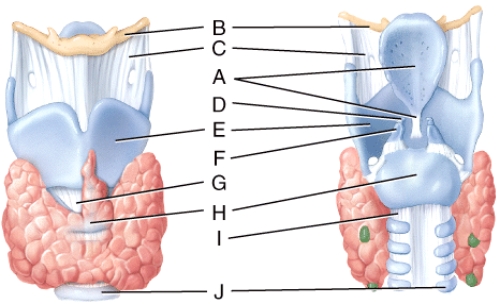
A)Thyrohyoid membrane
B)Corniculate cartilage
C)Cricothyroid ligament
D)Cricoid cartilage
E)Tracheal cartilage

A)Thyrohyoid membrane
B)Corniculate cartilage
C)Cricothyroid ligament
D)Cricoid cartilage
E)Tracheal cartilage

Unlock Deck
Unlock for access to all 85 flashcards in this deck.
Unlock Deck
k this deck
23
Where is the middle nasal concha?
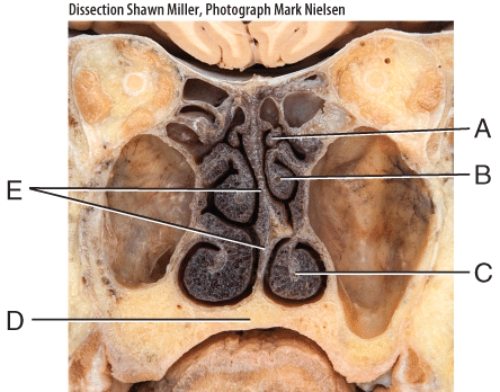
A)A
B)B
C)C
D)D
E)E

A)A
B)B
C)C
D)D
E)E

Unlock Deck
Unlock for access to all 85 flashcards in this deck.
Unlock Deck
k this deck
24
Where is the larynx?
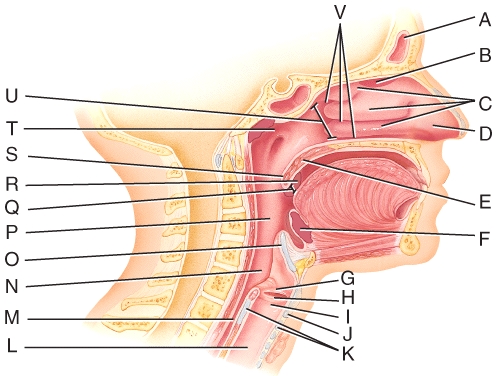
A)I
B)M
C)L
D)N
E)O

A)I
B)M
C)L
D)N
E)O

Unlock Deck
Unlock for access to all 85 flashcards in this deck.
Unlock Deck
k this deck
25
The MOST important factor that determines the percent of oxygen saturation of hemoglobin is
A)red blood count
B)volume of the blood
C)PO2
D)heart rate
E)PCO2
A)red blood count
B)volume of the blood
C)PO2
D)heart rate
E)PCO2

Unlock Deck
Unlock for access to all 85 flashcards in this deck.
Unlock Deck
k this deck
26
Where is the cricoid cartilage?
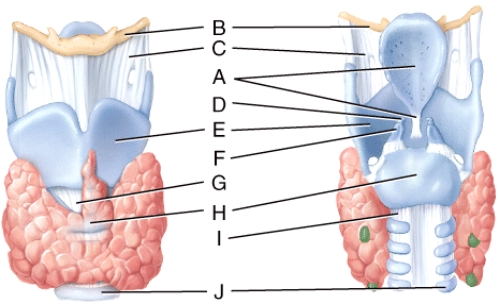
A)D
B)E
C)F
D)G
E)H

A)D
B)E
C)F
D)G
E)H

Unlock Deck
Unlock for access to all 85 flashcards in this deck.
Unlock Deck
k this deck
27
Where is the right bronchiole?
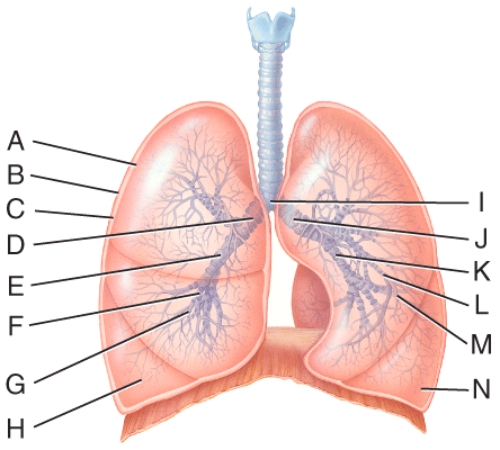
A)F
B)G
C)H
D)L
E)M

A)F
B)G
C)H
D)L
E)M

Unlock Deck
Unlock for access to all 85 flashcards in this deck.
Unlock Deck
k this deck
28
What is E pointing to?

A)Soft palate
B)Ethmoid bone
C)Hard palate
D)Nasal septum
E)Air cells

A)Soft palate
B)Ethmoid bone
C)Hard palate
D)Nasal septum
E)Air cells

Unlock Deck
Unlock for access to all 85 flashcards in this deck.
Unlock Deck
k this deck
29
A White baby boy is born after 7 months of gestation.He develops difficulty breathing and looks slightly blue.He is most likely suffering from
A)the flu
B)bacterial pneumonia
C)asthma
D)respiratory distress syndrome (RDS)
E)viral pneumonia
A)the flu
B)bacterial pneumonia
C)asthma
D)respiratory distress syndrome (RDS)
E)viral pneumonia

Unlock Deck
Unlock for access to all 85 flashcards in this deck.
Unlock Deck
k this deck
30
Where is the uvula?
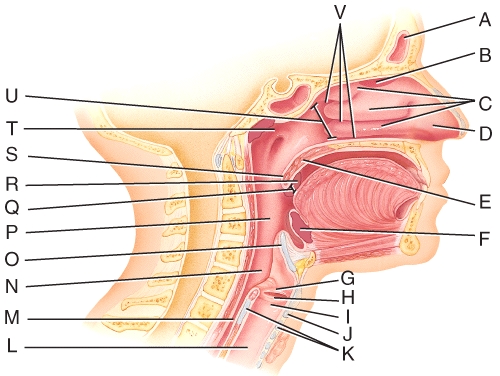
A)E
B)F
C)Q
D)S
E)U

A)E
B)F
C)Q
D)S
E)U

Unlock Deck
Unlock for access to all 85 flashcards in this deck.
Unlock Deck
k this deck
31
An individual suffers a blood clot in an artery that delivers blood to his leg.The leg begins to take on a blue hue,becomes colder than the rest of his body and he experiences numbness in the leg.He is most likely experiencing
A)anemic hypoxia
B)ischemic hypoxia
C)hypoxic hypoxia
D)histotoxic hypoxia
E)allergic hypoxia
A)anemic hypoxia
B)ischemic hypoxia
C)hypoxic hypoxia
D)histotoxic hypoxia
E)allergic hypoxia

Unlock Deck
Unlock for access to all 85 flashcards in this deck.
Unlock Deck
k this deck
32
Which of the following is a factor that does NOT affect hemoglobin's affinity for oxygen?
A)pH of blood
B)Partial pressure of the oxygen
C)Amount of oxygen available
D)Temperature
E)Respiratory rate
A)pH of blood
B)Partial pressure of the oxygen
C)Amount of oxygen available
D)Temperature
E)Respiratory rate

Unlock Deck
Unlock for access to all 85 flashcards in this deck.
Unlock Deck
k this deck
33
Where is the inferior nasal concha?

A)A
B)B
C)C
D)D
E)E

A)A
B)B
C)C
D)D
E)E

Unlock Deck
Unlock for access to all 85 flashcards in this deck.
Unlock Deck
k this deck
34
An individual is suffering from gangrene.This is a condition where circulation to tissues is interrupted causing a serious reduction in oxygenation to these tissues.Anaerobic bacteria invade the tissues and must be treated.If antibiotics don't work,an intelligent treatment may include
A)hyperbaric oxygenation
B)fresh air
C)drinking liquids with alcohol
D)a reduction in ambient oxygen levels
E)all of these are valid treatments
A)hyperbaric oxygenation
B)fresh air
C)drinking liquids with alcohol
D)a reduction in ambient oxygen levels
E)all of these are valid treatments

Unlock Deck
Unlock for access to all 85 flashcards in this deck.
Unlock Deck
k this deck
35
A man is found lying unconscious on the floor of his apartment during a very cold period.A space heater is nearby.His lips appear to be cherry red in color.He might be suffering from
A)carbon dioxide poisoning
B)sulfur dioxide poisoning
C)carbon monoxide poisoning
D)excessive oxygen intake
E)any of these is possible
A)carbon dioxide poisoning
B)sulfur dioxide poisoning
C)carbon monoxide poisoning
D)excessive oxygen intake
E)any of these is possible

Unlock Deck
Unlock for access to all 85 flashcards in this deck.
Unlock Deck
k this deck
36
Where are the nasal conchae?

A)A
B)C
C)T
D)U
E)V

A)A
B)C
C)T
D)U
E)V

Unlock Deck
Unlock for access to all 85 flashcards in this deck.
Unlock Deck
k this deck
37
What lines are pointing to tertiary bronchi?
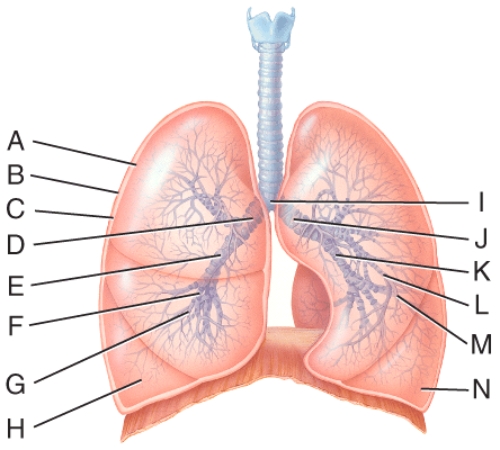
A)E and K
B)D and J
C)F and L
D)H and M
E)A and B

A)E and K
B)D and J
C)F and L
D)H and M
E)A and B

Unlock Deck
Unlock for access to all 85 flashcards in this deck.
Unlock Deck
k this deck
38
Which structure is also referred to as the Adam's Apple?
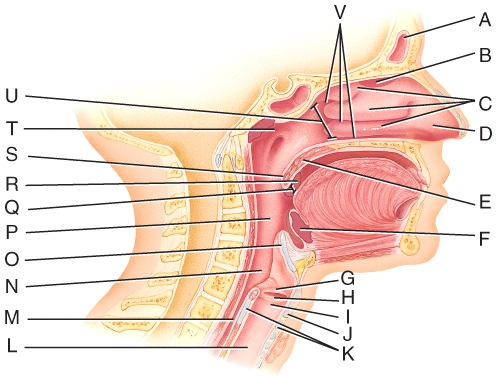
A)G
B)H
C)I
D)J
E)K

A)G
B)H
C)I
D)J
E)K

Unlock Deck
Unlock for access to all 85 flashcards in this deck.
Unlock Deck
k this deck
39
What is line J pointing to?
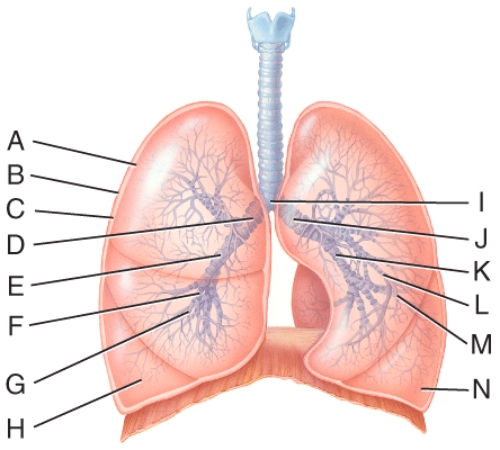
A)Right secondary bronchus
B)Left secondary bronchus
C)Right primary bronchus
D)Left primary bronchus
E)Carina

A)Right secondary bronchus
B)Left secondary bronchus
C)Right primary bronchus
D)Left primary bronchus
E)Carina

Unlock Deck
Unlock for access to all 85 flashcards in this deck.
Unlock Deck
k this deck
40
Which tonsils are found in the oropharynx?

A)V
B)R
C)S
D)Q
E)U

A)V
B)R
C)S
D)Q
E)U

Unlock Deck
Unlock for access to all 85 flashcards in this deck.
Unlock Deck
k this deck
41
If an individual experiences a broken rib which is displaced sufficiently to puncture a lung,even though the outer skin is not punctured,he will most likely develop
A)pneumothorax
B)hemothorax
C)atelectasis
D)bronchiectasis
E)cachexia
A)pneumothorax
B)hemothorax
C)atelectasis
D)bronchiectasis
E)cachexia

Unlock Deck
Unlock for access to all 85 flashcards in this deck.
Unlock Deck
k this deck
42
Which letter represents the primary gas exchange structure?

A)A
B)B
C)C
D)E

A)A
B)B
C)C
D)E

Unlock Deck
Unlock for access to all 85 flashcards in this deck.
Unlock Deck
k this deck
43
Which area in the figure represents a very deep inhalation,much greater than the tidal volume?
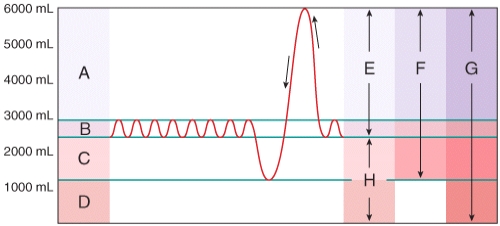
A)B
B)A
C)G
D)E
E)F

A)B
B)A
C)G
D)E
E)F

Unlock Deck
Unlock for access to all 85 flashcards in this deck.
Unlock Deck
k this deck
44
Describe the inward forces of elastic recoil,and explain why the lungs do not normally collapse during expiration.

Unlock Deck
Unlock for access to all 85 flashcards in this deck.
Unlock Deck
k this deck
45
Which area in the figure is the sum of the residual volume and the expiratory reserve volume?
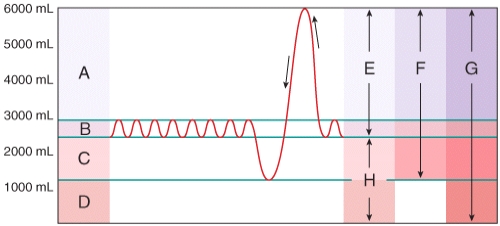
A)H
B)A
C)G
D)E
E)F

A)H
B)A
C)G
D)E
E)F

Unlock Deck
Unlock for access to all 85 flashcards in this deck.
Unlock Deck
k this deck
46
Which structure provides disease resistance within the lungs?
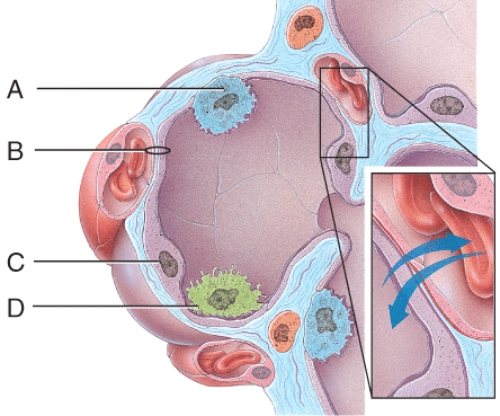
A)A
B)B
C)C
D)D
E)None of these choices

A)A
B)B
C)C
D)D
E)None of these choices

Unlock Deck
Unlock for access to all 85 flashcards in this deck.
Unlock Deck
k this deck
47
Normal quiet breathing is controlled by the
A)Pontine respiratory group
B)Medullary respiratory center dorsal respiratory group
C)Medullary respiratory center ventral respiratory group
D)Medullary respiratory center dorsal respiratory group and medullary respiratory center ventral respiratory group
E)all of these
A)Pontine respiratory group
B)Medullary respiratory center dorsal respiratory group
C)Medullary respiratory center ventral respiratory group
D)Medullary respiratory center dorsal respiratory group and medullary respiratory center ventral respiratory group
E)all of these

Unlock Deck
Unlock for access to all 85 flashcards in this deck.
Unlock Deck
k this deck
48
Which area in the figure is the sum of the tidal volume and the inspiratory reserve volume?
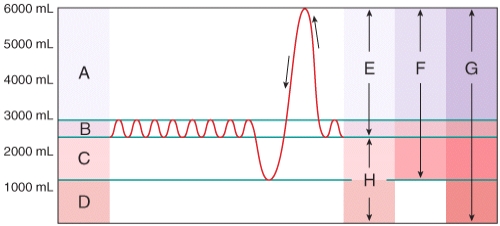
A)A
B)B
C)G
D)E
E)H

A)A
B)B
C)G
D)E
E)H

Unlock Deck
Unlock for access to all 85 flashcards in this deck.
Unlock Deck
k this deck
49
Describe and explain the effects of smoking on the functioning of the respiratory system.

Unlock Deck
Unlock for access to all 85 flashcards in this deck.
Unlock Deck
k this deck
50
Describe the neural,chemical,and physical changes that increase the rate and depth of ventilation during exercise.

Unlock Deck
Unlock for access to all 85 flashcards in this deck.
Unlock Deck
k this deck
51
Which area in the figure represents the volume of a normal breath?
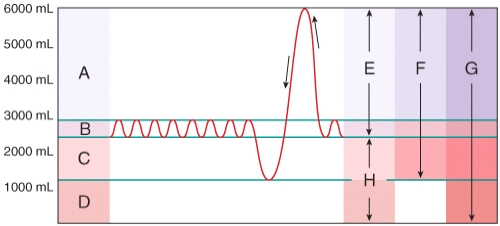
A)B
B)A
C)G
D)E
E)F

A)B
B)A
C)G
D)E
E)F

Unlock Deck
Unlock for access to all 85 flashcards in this deck.
Unlock Deck
k this deck
52
Which area in the figure is the sum of the vital capacity and residual volume?
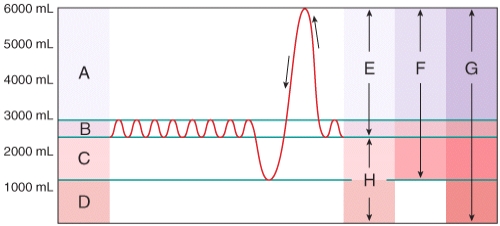
A)B
B)A
C)G
D)D
E)F

A)B
B)A
C)G
D)D
E)F

Unlock Deck
Unlock for access to all 85 flashcards in this deck.
Unlock Deck
k this deck
53
In chronic emphysema,some alveoli merge together and some are replaced with fibrous connective tissue.In addition,the bronchioles are often inflamed,and expiratory volume is reduced.Using proper respiratory system terminology,explain at least four reasons why affected individuals will have problems with ventilation and external respiration.

Unlock Deck
Unlock for access to all 85 flashcards in this deck.
Unlock Deck
k this deck
54
Which area in the figure is the sum of the tidal volume and the inspiratory reserve volume and expiratory reserve volume?

A)H
B)B
C)G
D)E
E)F

A)H
B)B
C)G
D)E
E)F

Unlock Deck
Unlock for access to all 85 flashcards in this deck.
Unlock Deck
k this deck
55
Which area in the figure represents the volume of air remaining in the lungs after a deep exhalation?
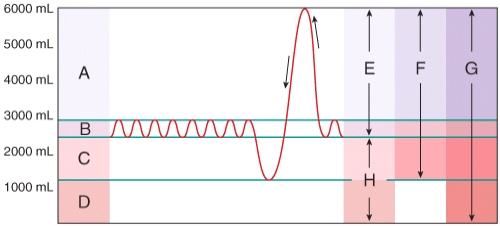
A)C
B)H
C)D
D)B
E)G

A)C
B)H
C)D
D)B
E)G

Unlock Deck
Unlock for access to all 85 flashcards in this deck.
Unlock Deck
k this deck
56
What are lines C pointing to?
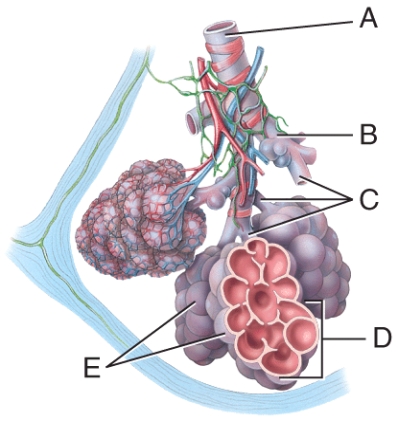
A)Terminal bronchiole
B)Respiratory bronchiole
C)Alveolar ducts
D)Alveolar sac
E)Alveoli

A)Terminal bronchiole
B)Respiratory bronchiole
C)Alveolar ducts
D)Alveolar sac
E)Alveoli

Unlock Deck
Unlock for access to all 85 flashcards in this deck.
Unlock Deck
k this deck
57
Where is the terminal bronchiole?
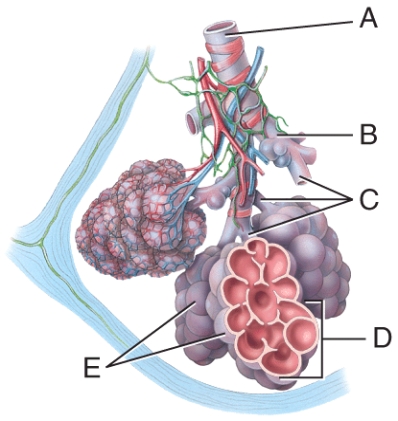
A)A
B)B
C)C
D)D
E)E

A)A
B)B
C)C
D)D
E)E

Unlock Deck
Unlock for access to all 85 flashcards in this deck.
Unlock Deck
k this deck
58
What is line B pointing to?
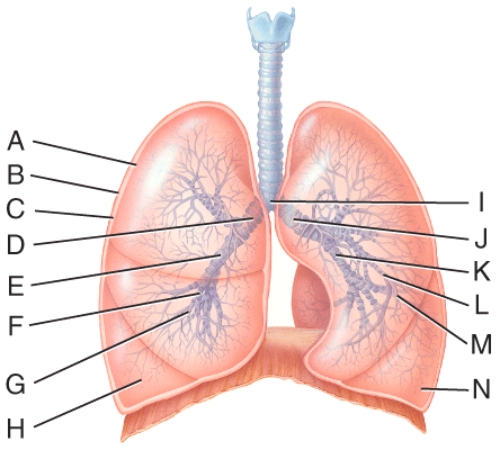
A)Carina
B)Visceral pleura
C)Parietal pleura
D)Pleural cavity
E)Diaphragm

A)Carina
B)Visceral pleura
C)Parietal pleura
D)Pleural cavity
E)Diaphragm

Unlock Deck
Unlock for access to all 85 flashcards in this deck.
Unlock Deck
k this deck
59
Which cells are the main sites of gas exchange?

A)A
B)B
C)C
D)D
E)All of these choices

A)A
B)B
C)C
D)D
E)All of these choices

Unlock Deck
Unlock for access to all 85 flashcards in this deck.
Unlock Deck
k this deck
60
Which cell secretes surfactant?
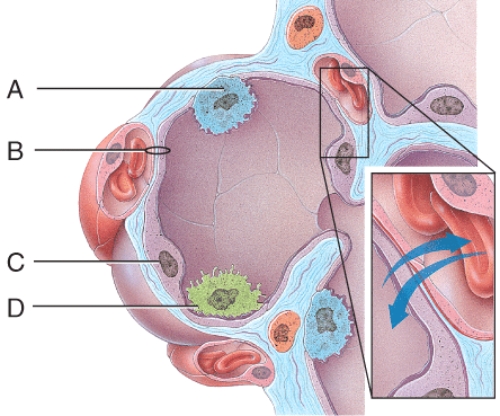
A)A
B)B
C)C
D)D
E)None of these choices

A)A
B)B
C)C
D)D
E)None of these choices

Unlock Deck
Unlock for access to all 85 flashcards in this deck.
Unlock Deck
k this deck
61
Which of the following is a spasmodic contraction of the diaphragm followed by spasmodic closure of the rima glottidis,which produces a sharp sound on inhalation?
A)sneezing
B)coughing
C)laughing
D)hiccupping
E)Valsalva maneuver
A)sneezing
B)coughing
C)laughing
D)hiccupping
E)Valsalva maneuver

Unlock Deck
Unlock for access to all 85 flashcards in this deck.
Unlock Deck
k this deck
62
Which of the following is an inhalation followed by many short convulsive exhalations during which the rima glottidis remains open and the vocal folds vibrate,accompanied by characteristic facial expressions?
A)sneezing
B)yawning
C)hiccupping
D)laughing
E)Valsalva maneuver
A)sneezing
B)yawning
C)hiccupping
D)laughing
E)Valsalva maneuver

Unlock Deck
Unlock for access to all 85 flashcards in this deck.
Unlock Deck
k this deck
63
Which of the following is a forced exhalation against the closed rima glottidis as may occur during periods of straining while defecating?
A)sobbing
B)coughing
C)crying
D)hiccupping
E)Valsalva maneuver
A)sobbing
B)coughing
C)crying
D)hiccupping
E)Valsalva maneuver

Unlock Deck
Unlock for access to all 85 flashcards in this deck.
Unlock Deck
k this deck
64
Which of the following is a deep inhalation through a widely opened mouth producing an exaggerated depression of the mandible,the precise cause of which is unknown?
A)sobbing
B)yawning
C)coughing
D)laughing
E)hiccupping
A)sobbing
B)yawning
C)coughing
D)laughing
E)hiccupping

Unlock Deck
Unlock for access to all 85 flashcards in this deck.
Unlock Deck
k this deck
65
The volume of one breath is called the
A)inspiratory reserve volume
B)expiratory reserve volume
C)tidal volume
D)vital capacity
E)forced expiratory volume
A)inspiratory reserve volume
B)expiratory reserve volume
C)tidal volume
D)vital capacity
E)forced expiratory volume

Unlock Deck
Unlock for access to all 85 flashcards in this deck.
Unlock Deck
k this deck
66
During quiet inhalation,which respiratory muscles contract?
A)diaphragm and external intercostals
B)diaphragm and internal intercostals
C)internal and external intercostals
D)diaphragm and external obliques
E)diaphragm and internal obliques
A)diaphragm and external intercostals
B)diaphragm and internal intercostals
C)internal and external intercostals
D)diaphragm and external obliques
E)diaphragm and internal obliques

Unlock Deck
Unlock for access to all 85 flashcards in this deck.
Unlock Deck
k this deck
67
Which of the following is a long drawn and deep inhalation immediately followed by a shorter but forceful exhalation?
A)sobbing
B)yawning
C)sighing
D)hiccupping
E)Valsalva maneuver
A)sobbing
B)yawning
C)sighing
D)hiccupping
E)Valsalva maneuver

Unlock Deck
Unlock for access to all 85 flashcards in this deck.
Unlock Deck
k this deck
68
Which of the following is an inhalation followed by many short convulsive exhalations during which the rima glottidis remains open and the vocal folds vibrate,accompanied by characteristic facial expressions?
A)sneezing
B)yawning
C)hiccupping
D)crying
E)Valsalva maneuver
A)sneezing
B)yawning
C)hiccupping
D)crying
E)Valsalva maneuver

Unlock Deck
Unlock for access to all 85 flashcards in this deck.
Unlock Deck
k this deck
69
Which of the following is a spasmodic contraction of the muscles of exhalation that forcefully expels air through the nose and mouth?
A)sobbing
B)sneezing
C)coughing
D)sighing
E)Valsalva maneuver
A)sobbing
B)sneezing
C)coughing
D)sighing
E)Valsalva maneuver

Unlock Deck
Unlock for access to all 85 flashcards in this deck.
Unlock Deck
k this deck
70
Which structure in the figure is the hyoid bone?
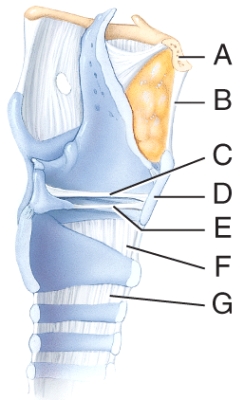
A)A
B)B
C)D
D)F
E)G

A)A
B)B
C)D
D)F
E)G

Unlock Deck
Unlock for access to all 85 flashcards in this deck.
Unlock Deck
k this deck
71
Where is the rhythmicity center for respiration?
A)in the medulla
B)in the pons
C)in the cerebrum
D)in the hypothalamus
E)in the cerebellum
A)in the medulla
B)in the pons
C)in the cerebrum
D)in the hypothalamus
E)in the cerebellum

Unlock Deck
Unlock for access to all 85 flashcards in this deck.
Unlock Deck
k this deck
72
Which structure in the figure is the ventricular fold?
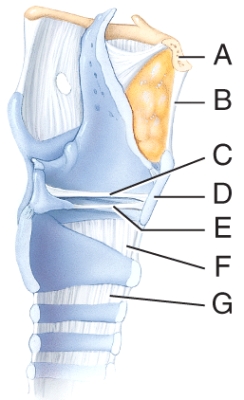
A)F
B)D
C)C
D)E
E)G

A)F
B)D
C)C
D)E
E)G

Unlock Deck
Unlock for access to all 85 flashcards in this deck.
Unlock Deck
k this deck
73
Which area in the figure represents a very deep exhalation,much greater than the tidal volume?

A)C
B)H
C)D
D)B
E)G

A)C
B)H
C)D
D)B
E)G

Unlock Deck
Unlock for access to all 85 flashcards in this deck.
Unlock Deck
k this deck
74
Which of the following is a series of convulsive inhalations followed by a single prolonged exhalation where the rima glottidis closes earlier than normal after each inhalation so only a little air enters the lung with each inhalation?
A)sobbing
B)sneezing
C)coughing
D)hiccupping
E)Valsalva maneuver
A)sobbing
B)sneezing
C)coughing
D)hiccupping
E)Valsalva maneuver

Unlock Deck
Unlock for access to all 85 flashcards in this deck.
Unlock Deck
k this deck
75
The branch of medicine that deals with the diagnosis and treatment of diseases of the ears,nose and throat is
A)otology
B)laryngology
C)pulmonology
D)otolaryngology
E)ophthalmology
A)otology
B)laryngology
C)pulmonology
D)otolaryngology
E)ophthalmology

Unlock Deck
Unlock for access to all 85 flashcards in this deck.
Unlock Deck
k this deck
76
Which of the following is a long drawn and deep inhalation followed by a complete closure of the rima glottidis,which results in a strong exhalation,pushing the rima glottidis open and sending a blast of air through the upper respiratory passages?
A)crying
B)sneezing
C)coughing
D)sighing
E)Valsalva maneuver
A)crying
B)sneezing
C)coughing
D)sighing
E)Valsalva maneuver

Unlock Deck
Unlock for access to all 85 flashcards in this deck.
Unlock Deck
k this deck
77
The surgical procedure used to cosmetically reshape the nose or to correct a deviated septum or fracture of the nose is called
A)otoplasty
B)rhinoplasty
C)mammoplasty
D)laryngoplasty
E)ophthalmoplasty
A)otoplasty
B)rhinoplasty
C)mammoplasty
D)laryngoplasty
E)ophthalmoplasty

Unlock Deck
Unlock for access to all 85 flashcards in this deck.
Unlock Deck
k this deck
78
With which body system does the respiratory system work to regulate the pH of body fluids?
A)muscular
B)digestive
C)nervous
D)endocrine
E)urinary
A)muscular
B)digestive
C)nervous
D)endocrine
E)urinary

Unlock Deck
Unlock for access to all 85 flashcards in this deck.
Unlock Deck
k this deck
79
Coryza is the medical name for
A)influenza
B)bacterial pneumonia
C)viral pneumonia
D)the common cold
E)asthma
A)influenza
B)bacterial pneumonia
C)viral pneumonia
D)the common cold
E)asthma

Unlock Deck
Unlock for access to all 85 flashcards in this deck.
Unlock Deck
k this deck
80
Which structure in the figure is the vocal fold?
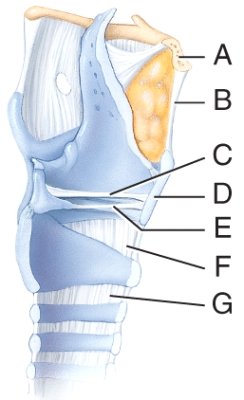
A)F
B)D
C)C
D)E
E)G

A)F
B)D
C)C
D)E
E)G

Unlock Deck
Unlock for access to all 85 flashcards in this deck.
Unlock Deck
k this deck



